
Acalypha is a genus of flowering plants in the family Euphorbiaceae. It is the sole genus of the subtribe Acalyphinae. It is one of the largest euphorb genera, with approximately 450 to 462 species. The genus name Acalypha is from the Ancient Greek ἀκαλύφη (akalúphē) ("nettle"), an alternative form of ἀκαλήφη (akalḗphē), and was inspired by the nettle-like leaves. General common names include copperleaf and three-seeded mercury. Native North American species are generally inconspicuous most of the year until the fall when their stems and foliage turn a distinctive coppery-red.

Johann Müller was a Swiss botanist who was a specialist in lichens. He published under the name Johannes Müller Argoviensis to distinguish himself from other naturalists with similar names.
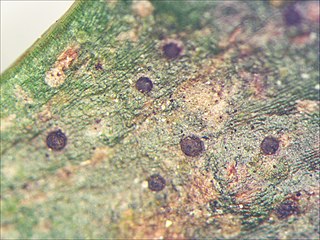
Tapellaria is a genus of leaf-dwelling lichens in the family Pilocarpaceae. The genus was circumscribed by lichenologist Johannes Müller Argoviensis in 1890, with Tapellaria herpetospora assigned as the type species.

Candelariaceae is a family of lichen-forming fungi in the order Candelariales. It contains four genera and about 65 species. The family was circumscribed by Finnish lichenologist Rainar Hakulinen in 1954 to contain the type genus, Candelaria.
Tylophorella is a genus of lichen-forming fungi in the order Arthoniales. The genus has not been placed into a family. Tylophorella was circumscribed by Finnish lichenologist Edvard August Vainio in 1890, with Tylophorella polyspora assigned as the type species. T. pyrenocarpoides was added to the genus in 1993.

Edvard August Vainio was a Finnish lichenologist. His early works on the lichens of Lapland, his three-volume monograph on the lichen genus Cladonia, and, in particular, his study of the classification and form and structure of lichens in Brazil, made Vainio renowned internationally in the field of lichenology.
Coppinsidea vainioana is a species of crustose lichen in the family Ramalinaceae. It occurs in Europe, where it grows on the bark of pine trees.
Rainar Alarik Hakulinen was a Finnish lichenologist and schoolteacher. He was noted as an expert on the lichen family Candelariaceae, and was known for his numerous phytogeographical publications about the boreal and arctic lichens of Finland, Northern Norway, and Russian Karelia.

Pyxine subcinerea is a species of foliose lichen in the family Caliciaceae. It has a pantropical distribution, and typically grows on bark, but less commonly on rocks. The lichen is characterised by its yellow medulla, soralia on the margins on the lobes that make up the thallus, and the presence of the chemical lichexanthone in the cortex.
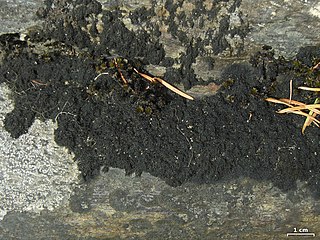
Ephebe lanata is a species of fruticose lichen in the family Lichinaceae, and the type species of the genus Ephebe. The lichen was first described as a new species by Swedish taxonomist Carl Linnaeus in his seminal 1753 work Species Plantarum, as Lichen lanatus. Finnish lichenologist Edvard August Vainio transferred it to Ephebe in 1888. In North America, it is known colloquially as the "rockshag lichen".
Clathroporina wainiana is a species of crustose lichen in the family Trichotheliaceae. It was formally described as a new species in 1902 by German lichenologist Alexander Zahlbruckner. The type was collected by Franz Xaver Rudolf von Höhnel in the Rio de Janeiro Botanical Garden. The species epithet honours Finnish lichenologist Edvard August Vainio.
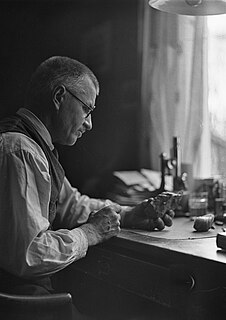
Veli Johannes Paavo Bartholomeus Räsänen was a Finnish lichenologist.

Johan Petter Norrlin was a Finnish botanist and a professor of botany at the University of Helsinki from 1879 to 1903. He was a pioneer of plant geography in Finland, and is also well known for his work on lichens and on the taxonomy of the apomictic taxa of the plant genera Hieracium and Pilosella.
Candelariella deppeanae is a species of lichen in the family Candelariaceae. Found in southwestern North America, it was formally described as a new species in 2007 by Swedish lichenologist Martin Westberg. The type specimen was collected in the Chiricahua Mountains at an elevation of 1,750 m (5,740 ft). Here, in an oak forest, it was found growing on a decorticated (barkless) part of alligator juniper. Most collections of the lichen are from the wood or trunks of this juniper plant; the species epithet deppeanae alludes to this close relationship.

Candelariella efflorescens, commonly known as the powdery goldfleck lichen, is a species of lichen in the family Candelariaceae. Found in North America, it was formally described as a new species in 1978 by Richard C. Harris and William R. Buck. The type specimen was collected by the second author from Hog Island Point State Forest Campground ; here, at the edge of a swamp, it was found growing on Populus balsamifera. The lichen has a temperate eastern North American distribution. Although it occurs most frequently on bark, it has also occasionally been recorded growing on wood. Before its description as a new species, it had most often been confused with Candelariella xanthostigma, Candelariella concolor var. effusa, and Lepraria candelaris when well developed.
Pulchrocladia ferdinandii is a species of lichen in the family Cladoniaceae. It was first formally described as Cladonia ferdinandii by Swiss lichenologist Johannes Müller Argoviensis in 1882. The specific epithet honours German-Australian botanist Ferdinand von Mueller, who collected the type specimen near Esperance, Western Australia. Rex Filson transferred the taxon to Cladia in 1970. In 2018, it was transferred to the newly circumscribed genus Pulchrocladia.

Graphina is a genus of script lichens in the family Graphidaceae. It has about 25 species. The genus was circumscribed in 1880 by Swiss lichenologist Johannes Müller Argoviensis. Müller Argoviensis did not indicate a type species for the genus in his original publication; David Hawksworth proposed to designate Graphina anguina as a lectotype in 1981.
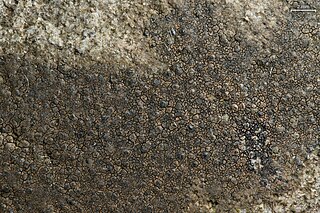
Willeya is a genus of saxicolous (rock-dwelling), crustose lichens in the family Verrucariaceae. It has 12 species. Most species are found in southeast Asia, although individual representatives are known from Australia, Europe, and North America.
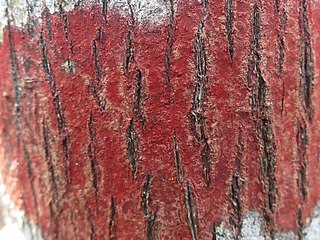
Pyrenula cruentata is a species of corticolous (bark-dwelling), crustose lichen in the family Pyrenulaceae. The lichen, characterized by its crimson-colored thallus and perithecial warts, has a neotropical distribution.

Pyrenula microcarpa is a species of corticolous (bark-dwelling), crustose lichen in the family Pyrenulaceae. It has a pantropical distribution. The lichen was formally described as a new species in 1885 by Johannes Müller Argoviensis. It has a white to grey-coloured thallus with ascomata measuring up to 0.7 mm in diameter.













